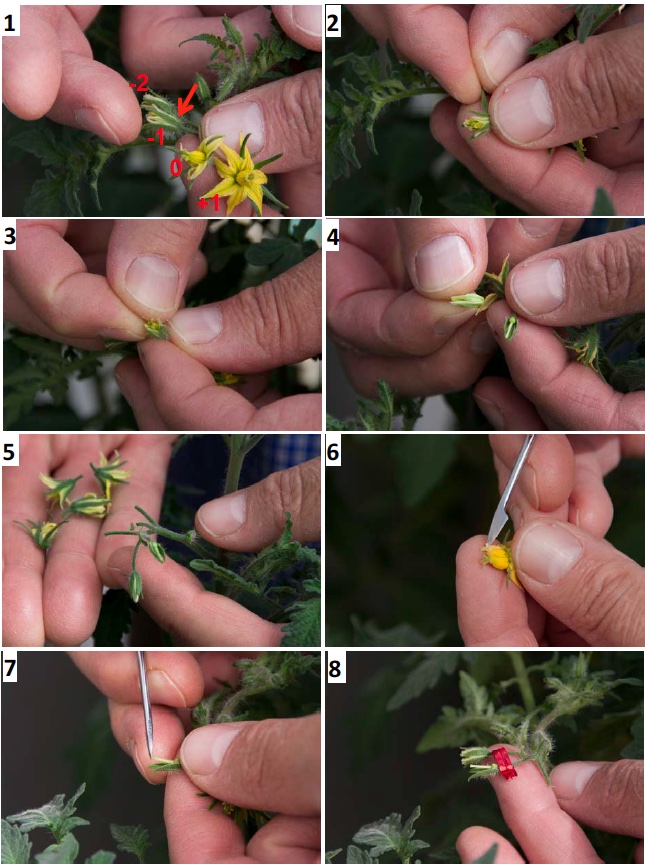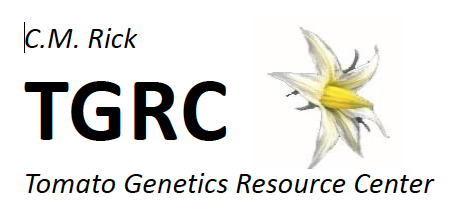Roger Chetelat and Scott Peacock
(11/2013)
Geneticists, breeders and even some avid backyard gardeners make crosses between tomato lines to generate hybrids and/or analyze the segregation of traits in later generations. Tomato is relatively easy to hybridize, and each cross yields a fairly large number of seeds (25-50 per fruit) of known parentage. The basic steps involved in emasculating and pollinating tomato flowers are outlined below. These recommendations reflect our preferences, however there are several alternative methods, and everyone develops their own favorite techniques over time.
List of Materials Needed
• Tomato plants with flowers to serve as the female and male parents
• Colored twist-ties or other types of labels
• A dissecting needle, scalpel, or other sharp and pointed instrument to collect pollen
• A bottle of 70% ethanol or rubbing alcohol to clean the pollinating needle between crosses
Basic Steps (refer to the corresponding images on the next page)
1. Choose flowers of the right stage. On each inflorescence (flower cluster), choose a well developed flower that has not yet opened. Immature buds at the -1 or -2 days stage are usually suitable (Rick 1980). By the time flowers have opened, they may have released some pollen, and therefore should not be used. Flowers showing a little yellowing of the petals are ideal, as these should be receptive to pollen and will set fruit if pollinated the same day they are emasculated. Younger flower buds should be pollinated 1-2 days after emasculation to ensure fruit set.
2. Remove sepals. Pull off two or more sepals to expose the petals on one side of the flower. The missing sepals also provide a marker to indicate that the fruit resulted from a cross pollination.
3-4. Remove petals and anthers. Pinch the side of the petals between thumb and forefinger, gently rock side to side, then pull straight off (away from flower). If the petal tears off but not the anthers, then remove more sepals and grab the petals from the other side. Avoid pinching the anthers so as not to damage the female parts of the flower inside (or transfer pollen). If this does not work well, try using a pair of sharp jeweler’s tweezers to remove the anthers by skewering them on both sides and pulling straight off. If all else fails, use a dissecting needling to cut off the anthers individually.
5. Remove older flower buds. All older flowers should be pulled off to prevent shedding of pollen onto the freshly emasculated flower.
6. Collect pollen from the male parent. Pick a mature flower(s) off the male parent (pollen donor). Using a dissecting needle or scalpel, slice open the anther cone lengthwise. Collect pollen on the tip of the needle by dragging upwards through the side of one of the anthers. You should have enough pollen to see the whitish clump of it on the tip of the needle. If you’re making large numbers of crosses with the same pollen source, it’s more efficient to collect pollen using a pollen collector (see below).
7. Apply pollen to emasculated flower. Holding the emasculated flower in one hand, apply the pollen to the stigma surface using the dissecting needle. Apply enough pollen to cover the entire stigma.
8. Tag flower. Fold a piece of colored twist tie around the flower to indicate it has been pollinated. Different colors of twist ties can be used to indicate different pollen parents or pollination dates. Wash hands and sterilize the pollinating needle in alcohol between crosses.

Pollen collection and storage
If you're only pollinating a few flowers, you can dig enough pollen out the anther cones (as above). Use a flattened dissecting needle to gather pollen by cutting a slit in the anther cone and scraping the contents on one antheridium at a time. If you have a lot of crosses to make, use a pollen collector to gather larger amounts of pollen. The VegiBee is a sonicating tool used to vibrate pollen out of tomato flowers; pollen can be collected into a spoon, a petri dish, or a microcentrifuge tube. It is sometimes beneficial to pick flowers and allow them to dry for several hours so they will open and release pollen more easily. Drying anthers in the sun or under an incandescent lamp that is at least 18" away from the pollen seems to work well. Pollen can be kept at -80°C for extended periods of time and thawed as needed. For best results, store pollen over desiccant in a sealed container, and minimize the number of time it is thawed by storing in small aliquots (Sacks and St. Clair 1996).
Pollination technique
Clean pollinating tools thoroughly with ethanol before starting. Apply pollen to the exposed stigma with a dissecting needle (see below), or by rubbing the stigma into the pollen. Transfer an excess of pollen onto the stigma to ensure good seed set. If fertilization was successful, you should notice the flower swelling after a few days. If fertilization did not occur, the flowers will abort and abscise. This can happen for various reasons – damage to the pistil during emasculation, low pollen viability or fertility, excessive temperatures, etc. – so it’s often worthwhile to make extra crosses to be sure that at least a few will take. For best results, repollinate
the same flowers one or two days later.

Marking flowers
A simple way to mark flowers that have been cross pollinated is with colored twist ties (Rick 1947). Cut them into short lengths (ca. 4 cm) and fold them around the pedicel of pollinated flower. Tags of different colors can be used to indicate the date of pollination or the pollen source. Striping tags with a colored pen provides additional color combinations. The crossing dates, pollen parents, or other treatments associated with each tag color can be recorded on a large manila shipping tag tied to the plant stake. Small stringed paper tags also work well for marking flowers.
References:
Rick, C.M. (1947) A flower marker for plant-breeding operations. Science 106: 645.
Rick, C.M. (1980) Tomato. In: Hybridization of Crop Plants. ASA-CSSA, Madison. pp669-680.
Sacks, E.J., and D.A. St. Clair (1996) Cyrogenic storage of pollen: effect on fecundity. HortScience 31: 447-448.
